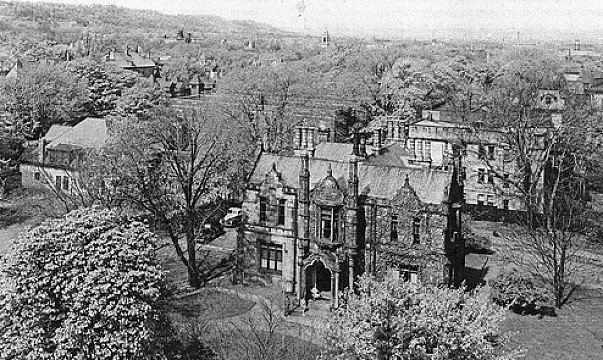Amisfield
1 Duke Street, Hamilton, Ontario
Completed in 1856, for Colin Dunlop Reid. Named for Amisfield Tower in Scotland, this Jacobean-Revival mansion at the corner of present day James and Duke Streets has suffered a similar fate as once befell New York's Hamilton Grange: Hemmed in and dwarfed by modern concrete blocks, today it is barely visible from the street and as a tired apartment building it is a mere shadow of its former self....

This house is best associated with...
Colin Reid, a bachelor, was a successful lawyer and acted as land agent to Peter Hunter Hamilton (1800-1857), brother of the founder of the city that bears their name. Reid purchased a one acre plot of land outside the city and in 1852 set about building his imposing home with slabs of grey limestone cut from the Niagara Escarpment. The design is often attributed to Hamilton's best known architect of that period, Frederick James Rastick (1819-1897) - he completed Highfield in 1861 - but there is no mention in his books of this being commissioned, or even a project that resembled its construction.
By 1854, the stone walls containing the landscaped gardens were complete but then work tailed off until a further push was made and the whole was finally completed in 1856. At that time, it occupied an entire block, bordered by the streets of James, Duke, Robinson and MacNab. It was entered via a large wrought iron gate and the drive terminated in a horse-shoe before the ivy-clad mansion.
When Reid died, he left his home to James Reid (d.1884), who was probably a nephew. James Reid was Hamilton's well-documented maker of bespoke furniture whose staff of 220-skilled craftsmen and women made everything by hand at a time when furniture was starting to become mass-produced by machinery. After his death in 1884, the mansion was purchased by Mrs Jean Charteris Thomson (1799-1887), a native of Dumfries-shire in Scotland and then the elderly widow of a wealthy lumber merchant, William Thomson.
The Charteris-Thomson Family
When Reid died, he left his home to James Reid (d.1884), who was probably a nephew. James Reid was Hamilton's well-documented maker of bespoke furniture whose staff of 220-skilled craftsmen and women made everything by hand at a time when furniture was starting to become mass-produced by machinery. After his death in 1884, the mansion was purchased by Mrs Jean Charteris Thomson (1799-1887), a native of Dumfries-shire in Scotland and then the elderly widow of a wealthy lumber merchant, William Thomson.
The Charteris-Thomson Family
Mrs Thomson died in 1887, leaving the property to her eldest son, Robert Charteris Thomson (1834-1898). It was Robert who named it "Amisfield" for Amisfield Tower in Dumfries-shire which was built by his ancestor, Sir John Charteris, in 1600.
In Robert's time, the castle fronted Duke Street and he lived there with his wife, Anne Laurence VanEvery, and their large family. Robert died in 1898 leaving the house and its contents to be divided between his family. By 1902, his widow, Anne, had bought each of their children's shares and continued to live there until her death. Her eldest son, Joseph James Charteris Thomson (1864-1952), had taken his father's place as President of R. Thomson & Co., lumber merchants, and after his wedding in 1905 to Margaret, daughter of Sir Thomas Wardlaw Taylor (1833-1917) - the presiding judge at the trial in 1885 of Louis Riel who led the Métis Rebellion - they too moved into Amisfield.
Amisfield Today
In Robert's time, the castle fronted Duke Street and he lived there with his wife, Anne Laurence VanEvery, and their large family. Robert died in 1898 leaving the house and its contents to be divided between his family. By 1902, his widow, Anne, had bought each of their children's shares and continued to live there until her death. Her eldest son, Joseph James Charteris Thomson (1864-1952), had taken his father's place as President of R. Thomson & Co., lumber merchants, and after his wedding in 1905 to Margaret, daughter of Sir Thomas Wardlaw Taylor (1833-1917) - the presiding judge at the trial in 1885 of Louis Riel who led the Métis Rebellion - they too moved into Amisfield.
Amisfield Today
It would appear that Joe Charteris Thomson sold his family home sometime after World War Two. By the late 1940s, it had been acquired by Cecil R. Day, by which time it had come to be referred to as "The Castle". In 1950, despite having been considered as a potential home for the Art Gallery of Hamilton, it found itself abandoned and it was only saved from demolition when it was sold to developer Alex Brown who attached the annex known as "Castle Building" and converted the old house into apartments.
In 1951, the lawn that ran from the Castle down to James Street South was offered to the City of Hamilton to be used as parkland, but the offer was refused. In its place, a gas station was built on this land until that too was replaced in 1980 by the modern plaza that now all but completely hides the mansion from James Street.
You May Also Like...
Categories
Styles
Share
Frederick James Rastrick and the Changing Face of Hamilton in the 1850s, from raisethehammer.org; The Life Writings of Mary Baker McQuesten: Victorian Matriarch (2006), by Mary J. Anderson; At Home in Upper Canada (1970), by Jeanne Minhinnick; Footsteps in Time (Vol. 1) by Bill Manson; The Grand Old Buildings of Hamilton by Brian Henley; and, Amisfield Castle, from historicalhamilton.com
Connections
Be the first to connect to this house. Connect to record your link to this house. or just to show you love it! Connect to Amisfield →










